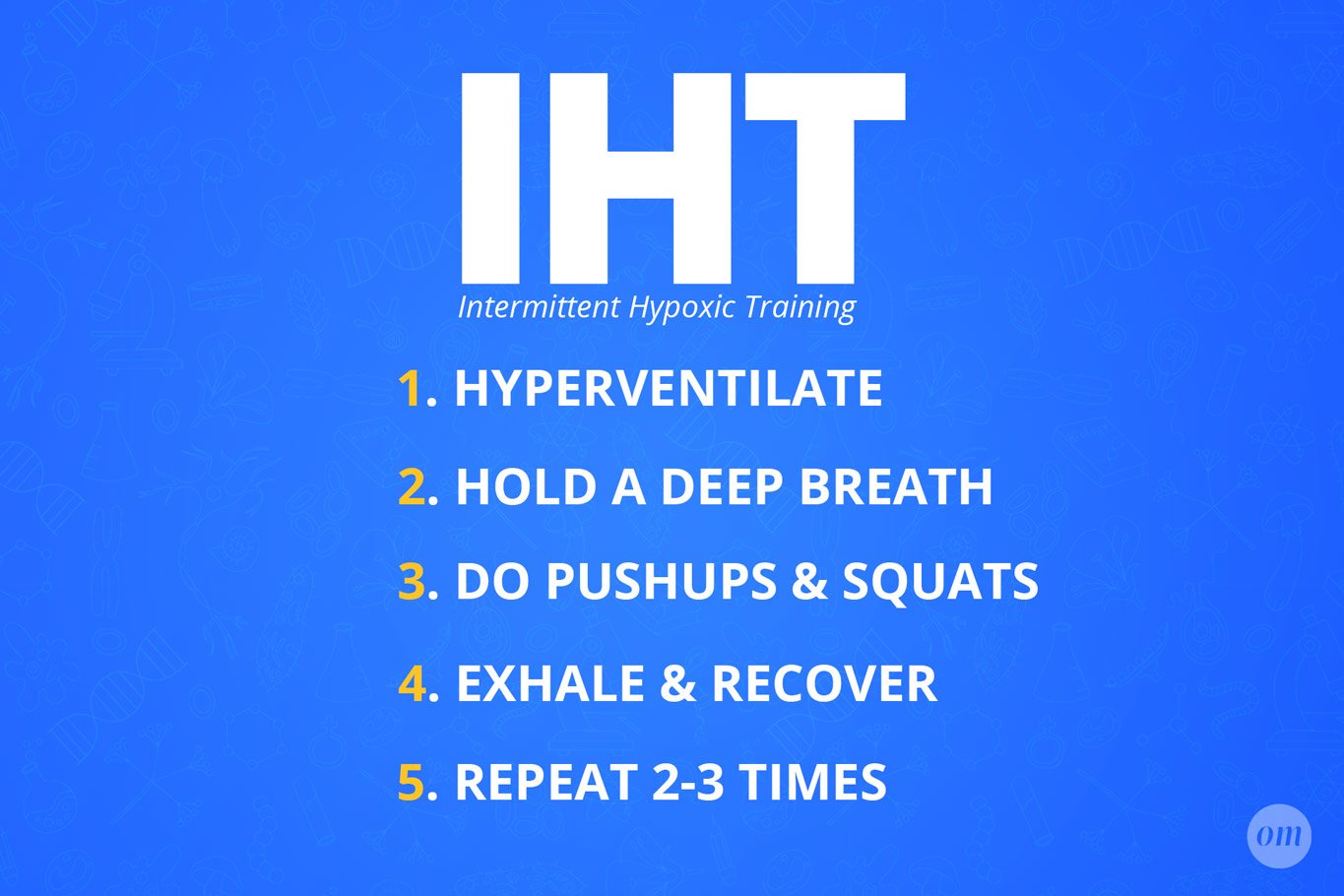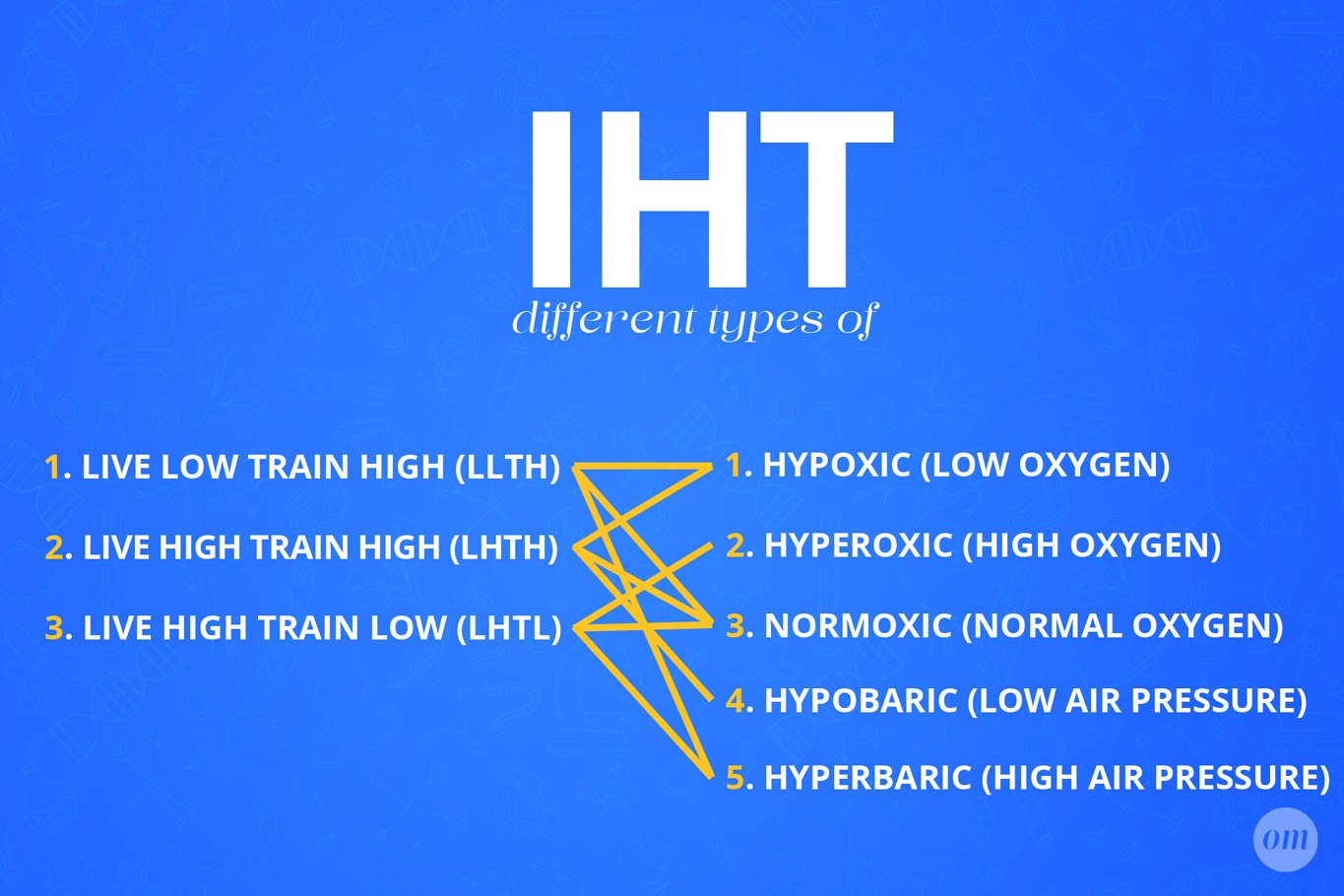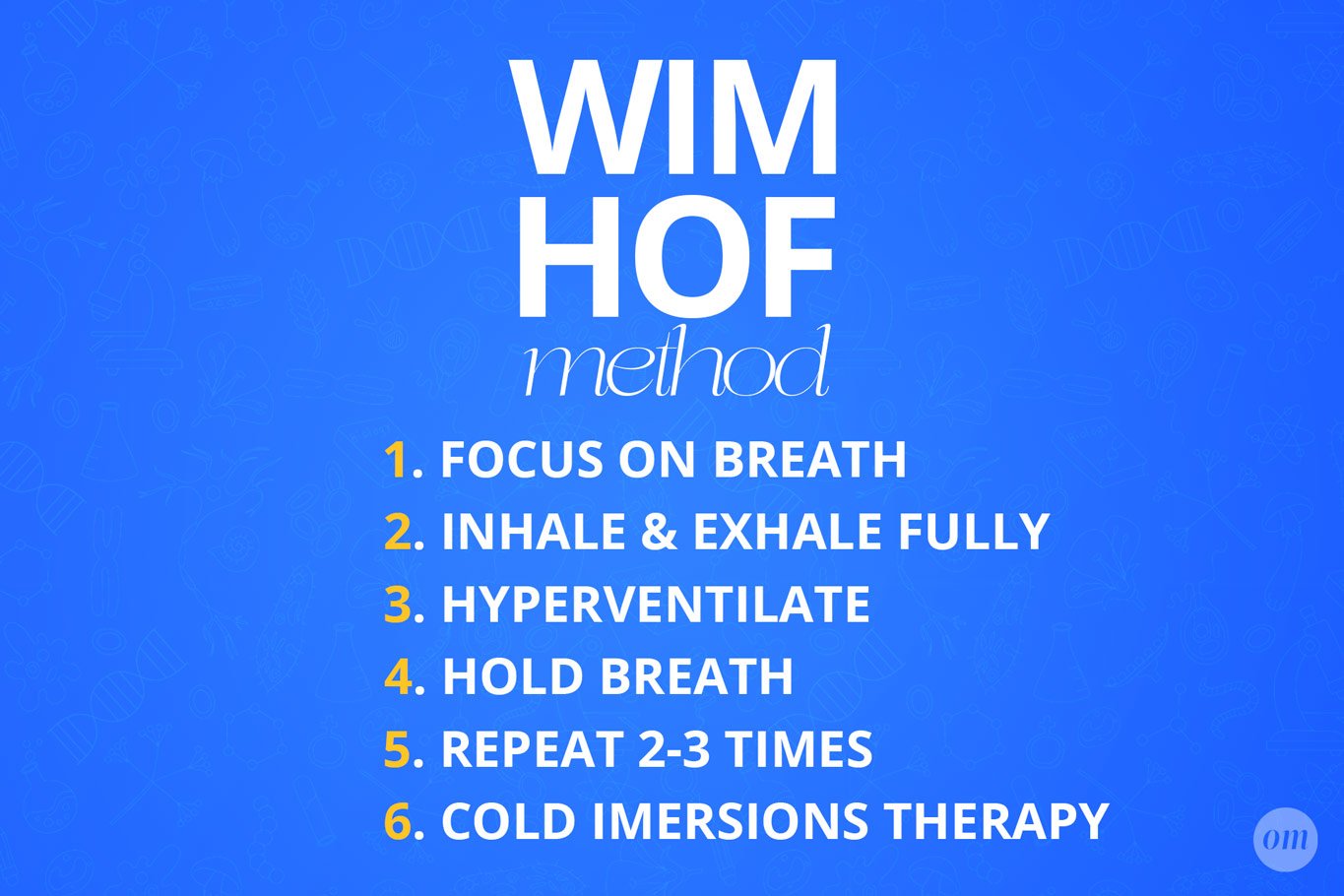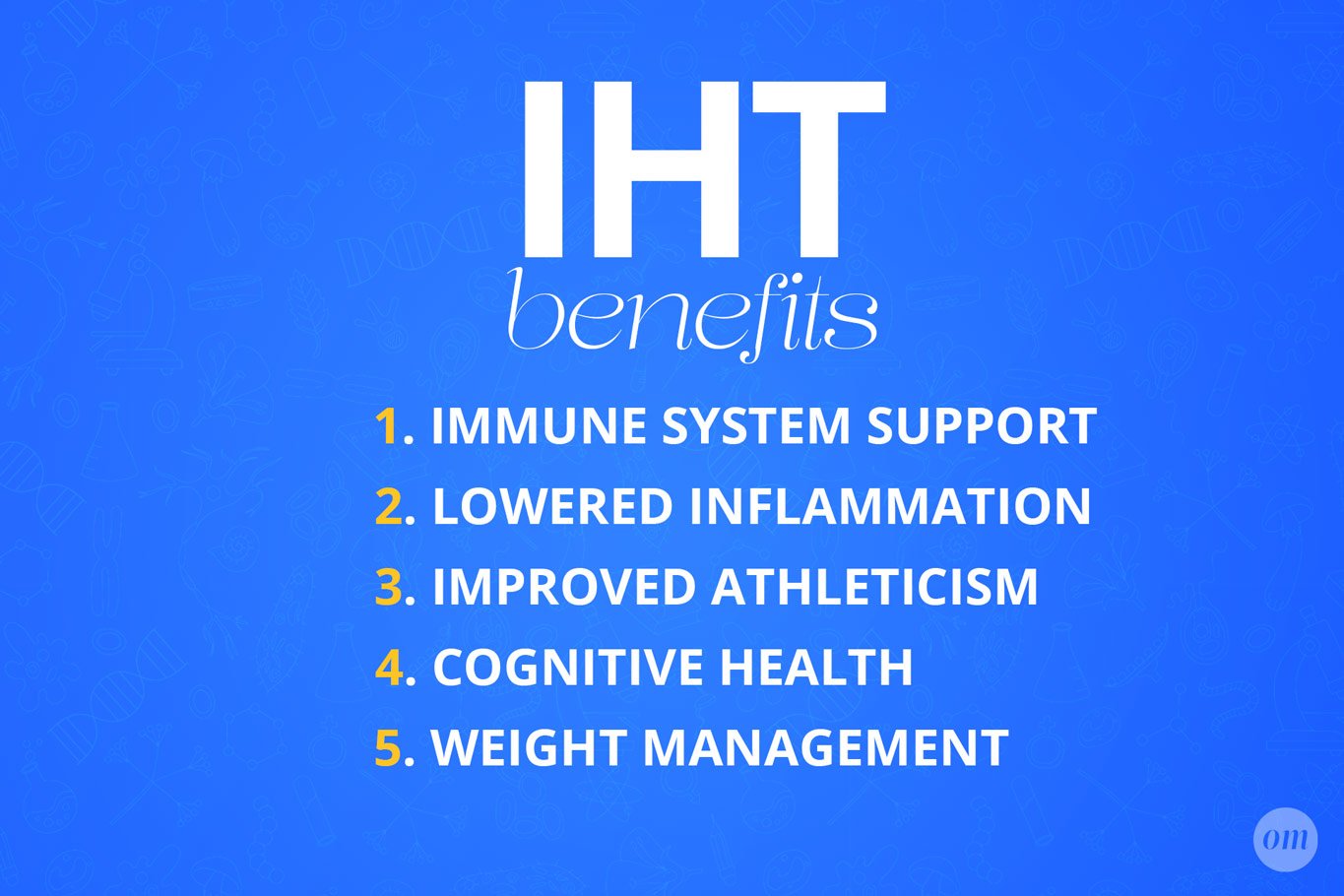INTERMITTENT HYPOXIC TRAINING (IHT) involves exposing the body to low-oxygen states in such a way to provide health benefits; be those cognitive, athletic, or something else. I use a simplified version of IHT to jump-start myself in the mornings.
In 5 short minutes, my body responds as if I’d worked out for nearly an hour. This article outlines the simple IHT routine I use as well as more involved and scientifically supported approaches. IHT is pretty stressful on the body and I recommend anyone considering it have a talk with their doctor to make sure somethings not likely to come loose.
Table of Contents
Highlights
- IHT allows one to reap the health benefits of low-oxygen states
- High-altitude training is a common form of IHT
- Holding your breath while doing push-ups is a simplified version of IHT
- The Wim Hof Method is a type of IHT
- Cold Immersion Therapy & IHT have a lot in common
- Few studies on IHT, but initial support seems strong
IHT Jump Start

IHT training routines can accommodate those looking to shave minutes off their marathon times or, like me, help stabilize their hormones and optimize mental performance. They can involve oxygen tanks, expensive masks, and teams of researchers. IHT can also be condensed into a simplified routine you can do right now in less than 5 minutes. Here’s how to get started with IHT in 5 easy steps, in as few as 5 uncomfortable minutes.
- Hyperventilate: Breath in deeply and forcibly exhale until your lungs are clear 5-10 times. I imagine that I’m pushing the air from the bottom of my lungs out. It’s a very muscle-clenching type push compared to regular exhalation.
- Hold a Deep Breath: Take one final deep breath, about 90% full, and hold it. I’ve found that taking too deep a breath can cause some discomfort during the following exercises.
- Do Push-Ups: While holding your breath, do as many push-ups as you can. If you run out of arm strength before you need to breathe, stand up and start doing some free-standing squats. The goal is to get your muscles to use up oxygen.
- Breath Normally: When you can no longer fight the biological imperative to breathe, take a deep breath and start breathing normally again. If you tend to push yourself, I suggest taking a knee here to get used to any lightheadedness you might experience.
- Repeat 2-3 Times: Allow yourself to recover for a few minutes, I wait until my heart rate returns to my normal resting heart rate, and then start over from step 1. I notice a marked reduction in the number of push-ups I can do if I don’t rest long enough.
Different Types of IHT

The above IHT method is probably, by most measures, pretty half-assed. IHT is leveraged by many professional athletes to boost their performance on game day. There’s a science behind it, different ways to approach it, and—of course—plenty of money to spend on IHT if that’s your thing. It’s certainly not mine.
Quick Terminology
- Hypoxic: Lower than normal levels of oxygen
- Hyperoxic: Higher than normal levels of oxygen
- Normoxic: Levels of oxygen found in normal conditions (outside, for example)
- Hypobaric: Lower than normal air pressure
- Hyperbaric: Higher than normal air pressure
Traditional Types of IHT
IHT has been a tool among high-level athletes for as long as I can remember. I’m sure longer than I’ve been around. The classical IHT routine is training at high-altitudes for low altitude races. Modern IHT methods often try to replicate oxygen and barometric pressure conditions of high altitude training (R)(R).
- Live Low Train High (LLTH): Training in high-altitude conditions while living, and intending to compete at, near sea-level conditions. One of the newer forms of IHT being used by professional trainers and athletes.
- Living High Training High (LHTH): Training in high altitude conditions with the expectation of competing in similar conditions. An example would be someone temporarily residing in a high altitude location for prolonged training.
- Living High Training Low (LHTL): Training in low-altitude conditions with the expectation of competing in similar conditions. An example would be someone living in the Colorado Rockies training in higher-oxygen environments for an upcoming marathon at sea level.
Other Notable Types of IHT
In addition to the methods and means above, l found several other types of hypoxic training (not always intermittent) worth noting (R). These methods could easily be adjusted to accommodate varying oxygen or air-pressure conditions. To my knowledge, they don’t represent any standardized training program vernacular but are useful in illustrating different approaches.
- Continuous Low-Intensity Hypoxic Training (CHT) Long-lasting physical exercise in a continued low-oxygen state. An example would be spending 90 minutes on an exercise bike while breathing a low-oxygen air mixture through a mask.
- Interval/Intermittent Hypoxic Training (IHT) Mixed exposure to normal oxygen (or high) and low oxygen states during exercise or training. An example would be the breath-holding/push-ups routine I described earlier.
- Repeated Sprint Training in Hypoxia (RST) A type of IHT specific to sprinting where a mask with low-oxygen mixtures is used while running. Low oxygen may be used during running, during recovery, or both.
- Resistance Training in Hypoxia (RTH) Doing non-aerobic resistance training during states of hypoxia. It can be used to describe IHT or CHT during heavy lifting.
The Wim Hof Method

I didn’t come up with my IHT routine via divine inspiration. I heard about it while watching some videos on Wim Hof’s YouTube channel. Wim has gained international fame for accomplishing such feats as climbing Mount Everest in shorts (only shorts), running marathons in the Arctic Circle (again, in nothing but shorts), and immersing himself in ice baths for hours at a time.
The Wim Hof method involves using cold-immersion therapy and breathing exercises to help the body become more flexible in its adaptation to changing environments, particularly cold environments. The Wim Hof method is billed as providing an innate system for helping regulate hormones, increase energy, sleep better, improve athletic performance, improve cognitive performance, and boost the immune system. Among its many claims: you’ll be able to take cold showers without getting cold, provided you master its breathing techniques.
The Wim Hof method has more science to support its claims than most guru-sounding workout routines, but it’s still far from what I’d consider solid. My personal experience with it has been very positive and I mention it here mainly to highlight Wim’s use of physical exercise during hypoxic states as a way to condition the body and influence the autonomic nervous system (R). That last bit is something that scientists didn’t really believe was possible until Wim rolled up.
IHT Benefits

I want to stress that the Science behind IHT, as well as related practices like the Wim Hof Method, is very young. There are a handful of studies that offering promising conclusions but most are very small in scope, haven’t been replicated, or offer only varying overlap in their methods.
For example, it’s hard to compare the data from a dozen people doing squats to a dozen people walking on a treadmill for 90 minutes. It can be done—it’s just doesn’t provide what I’d call “solid support.” So dive into IHT and recognize how it might benefit your health but don’t assume the effects noted in a 12-person study are guaranteed—or even likely.
Inflammation
One study of 17 people found that training in low-oxygen settings 3 days a week, for 4 weeks, produced a significant improvement of vascular health (R). Researchers were using this measurement to help determine the benefit that IHT might have for lowering C-Reactive Protein and risk markers for Diabetes.
These researchers concluded that IHT showed great promise in this area but noted their study has several limiting factors. Basically, a vote for IHT but with the plea for further research. IHT has also shown inflammation-lowering activity in numerous other areas including the gut lining, organs, tissue, and skin (R).
Immune System
Researchers studying Wim Hof’s cold water immersion and breathing exercises suggest that the combination of the stress from exposure to extreme cold, combined with deep breathing exercises, might stimulate the body’s endocannabinoid system. Kind of like taking CBD oil, without all the blurry State regulations clouding things up (R).
Brain Health
Brain-derived neurotrophic factor (BDNF) is a compound responsible for helping repair brain tissue and help developing brain cells find their purpose. Generally speaking, increasing BDNF levels is equated to regularly repairing and maintaining optimal brain health. IHT has been studied as a means to increase BDNF levels, though there have been some conflicting results (R).
Brain cells are particularly susceptible to low-oxygen states and irreversible brain damage can occur quickly when one is deprived of oxygen. For example, for every minute a stroke is left untreated up to 2 million brain cells can die. The human body has evolved in such a way to help reduce brain damage and repair damage incurred from hypoxic states. When hypoxia is introduced without systemic damage to repair (i.e. not passing into a coma) the body gets to just do a little house-keeping. Or so I like to think of it anyway—I’m no doctor.
Weight Control
IHT has been studied for its ability to help regulate the hormones ghrelin and leptin though results have been mixed (R)(R). In general, it seems that more acute states of hypoxic are better able to influence certain hormones associated with healthy eating habits. In other words, hyperventilating and pushups are probably going to be more effective than walking a few miles at high altitudes.
These hormones are responsible for providing the feeling of being full after a meal. The less active these hormones are, the more one tends to eat. It’s thought that action taken to help regulate the healthy release of these hormones is likely to help maintain healthier eating habits, ultimately resulting in a healthier weight.
Athletic Performance
Hypoxic states have been billed as a means to improve athletic performance for as long as I can remember. The most common; high-altitude training, is essentially a way to force the body to adapt to performing under more rigorous conditions than expected in actual competition. Want to be stronger in the 10th round? Train for 13—or train for 10 in the Colorado Rockies (assuming you’re fighting sea level somewhere.)
Intermittent Hypoxic Training in more controlled ways—a less boost-your-airline-miles kind of way—has been the focus of more modern research. Studies have shown improvements of many common biomarkers associated with overall performance and recover such as VO2max, heart rate variability, and markers of inflammation. Most studies that I’ve seen have been conducted on small numbers of healthy individuals with methods different enough that make direct comparison difficult.
Other Benefits
States of varying oxygenation have also been investigated for their impact on human health in many other studies. Hyperbaric chambers (hyperoxic) have been studied for their impact on hypertension, immunity, heart health, obesity, and general wellness (R).
My Person Experiences with IHT
I heard of IHT a few years ago when Wim Hof was first gaining notoriety within the self-optimization circles. At first glance, I thought it was another silly routine to catch the attention of the masses for another news cycle. I’m always open to trying new ways to make my body run a bit more smoothly—especially when they don’t involve money—so I said whatthehellwhynot.
That said, I’d been reading about how cold-showers can help vagal tone, had read about how hypoxia can increase brain-derived neurotrophic factor (BDNF), though not much could go wrong, so I gave it a whirl. I was surprised by the almost immediate results.
First, the shower didn’t feel that cold—I also wasn’t in a terrible hurry to towel up and seek warmth afterward (something I do even after scalding hot showers.) My interest was piqued, to say the least. All this took less than 10 minutes and I was left, for the remainder of the day, feeling as if I’d had an hour-long workout. I felt calm, relaxed, and better able to focus on my work for the remainder of the day.
Scientific Support
The types of IHT mentioned earlier, as well as cold water immersion (a.k.a. Ice baths), cryotherapy, and even cold compresses are all used by athletes from varying levels of skill to help recover from injury and workouts. The thing is—there’s not a strong consensus as to why these therapies work (R) and there is considerable debate as to whether or not they work at all.
My personal experience has been very positive with the very amateurish IHT routines I’ve tried. If I were a betting man I’d say a lot of the skepticism surrounding IHT comes from a lack of science—not a barrage of conflicting results. I think it’s important to hear both sides of any story. Below are two small studies that gauged the impact of simple cold-immersion techniques on recovery from physical performance
IHT Support by the Numbers
In one paper I came across, researchers analyzed 31 separate studies that investigated the outcomes of varying types of exposure to hypoxic states (R). Each study they considered included the following criteria:
- Test subjects actively trained in low oxygen states (not just recovery)
- Low oxygen states did not exceed 3 hours in a single day (prolonged hypoxia)
- Training methods fell into one of the categories from above: IHT, CHT, RST, or RSH
Among the studies considered, the researchers found that there were conflicting reports of the benefits offered by IHT training. Below is a quick summary illustrating
| Training Type | Did Improve Performance | Didn’t Improve Performance | # Studies Considered |
|---|---|---|---|
| Interval Hypoxic Training (IHT) | 1 | 6 | 6 |
| Repeated Sprint Training (RSH) | 2 | 1 | 3 |
| Continual Hypoxic Training (CHT) | 5 | 17 | 22 |
| Resistance Training Hypoxia (RTH) | 1 | 3 | 4 |
| Totals | 9 | 27 | 35 |
Note: Some studies methods fell into multiple categories for consideration, resulting in 35 total points of consideration from 31 unique studies.
By the numbers— low-oxygen training has pretty weak scientific support in my opinion. The researchers of this study ultimately concluded that, among the varying types of hypoxic training, short-term intermittent hypoxic training offers the greatest chance of improving athletic performance. They also note the importance of including high-intensity training in normal oxygen states to support the benefits of IHT.
Intermittent Hypoxic Training & Cold Immersion Therapy
I didn’t really connect the dots between cold-water immersion and hypoxic training at first. As it turns out, hypoxia and hypothermia are very interrelated. During hypothermia, hypoxia starts to set in on a cellular level as the blood flow starts to be redirected to organs and center mass.
During states of hypoxia, core body temperatures begin to drop as oxygen fails to reach one’s extremities. Humans and animals alike have evolved many ways to help deal with both of these states, whether preparing for hibernation or minimizing brain damage from almost drowning (R).
The hyperventilation > push-ups > repeat method is described by Wim as a way to measure one’s improvement of athletic ability during cold immersion and IHT. He claims that, after practicing his method, one can do more push-ups while holding their breath than they could without holding their breath prior. I can back that up personally and will add this: I was amazed at how many pushups I could do while holding my breath after only practicing this method for a few weeks.
A Vote Against Cold-Water Immersion
In one small study, participants completed a series of resistance training exercises and then followed-up their workout with one of two recovery routines:
a.) cold-water-immersion, or;
b.) “active recovery” on a stationary bike.
Researchers measured levels of inflammatory markers in the blood as well as biopsied muscle tissue—pre and post-workout–of participants from each group. The results between groups were then compared to assess whether cold immersion therapy offered any benefit over traditional recovery routines.
They concluded that cold immersion therapy offered provided no significant reduction in post-exercise inflammatory markers when compared to active recovery (R). In other words, 10 minutes on a stationary bike will help muscles recover as well as 10 minutes in an ice bath. Part of me is really relieved to hear that.
A Vote For Cold Immersion
In another small study, researchers investigated the differences between cold water immersion and warm water immersion on post-workout recovery. For this study, levels of an inflammatory marker in the blood, Interleukin-6 (IL-6) was measured pre-workout, and again at several intervals post-workout.
Participants of this study underwent an exercise period of 90 minutes on a treadmill at an incline of five degrees. Body temperature and blood levels of IL-6 were measured following this workout. Next, participants were divided into one of two groups:
- Coldwater immersion, or;
- Warm water immersion
Researchers measured core body temperature and levels of IL-6 (among other things) at set intervals following training. Their stated goal was to determine if water temperature had any marked impact on the reduction of inflammation markers following exercise. In addition, they compared the rate at which these inflammatory markers dropped with respect to the rate at which core body temperature dropped.
This study found that, compared to warm water, cold water immersion therapy following physical exercise resulted in significantly lower levels of inflammatory markers (R). Not exactly an apples-to-apples comparison with the first study but an argument for cold-immersion therapy offering a marked advantage in some cases.
Final Thoughts
IHT certainly gets my vote for supporting health and a general sense of well-being. I won’t ramble about how IHT has a lot of benefits supported by Scientific study because, in my opinion, it really doesn’t yet. Current studies paint a positive picture for IHT but, as many of the authors and researchers note: more research is needed.
I’m a fan of IHT for several reasons. Among them are the following:
- Can be done for free
- Can be done quickly and effectively
- Science exists to describe how it might offer benefits
- Can benefit people of any athletic capacity
- Is very flexible in design allowing for varying intensity
- It works for me
For example, I like doing a few sets of hyperventilating/pushups/free-standing squats in the morning to jumpstart my body. If I feel squirrely, I know I can throw in a cold shower and breath focused meditation (per the Wim Hof Method’s outline) for more profound results.
The only parting advice I’d offer is that anyone new to IHT should start slow and be prepared to experience light-headedness.


